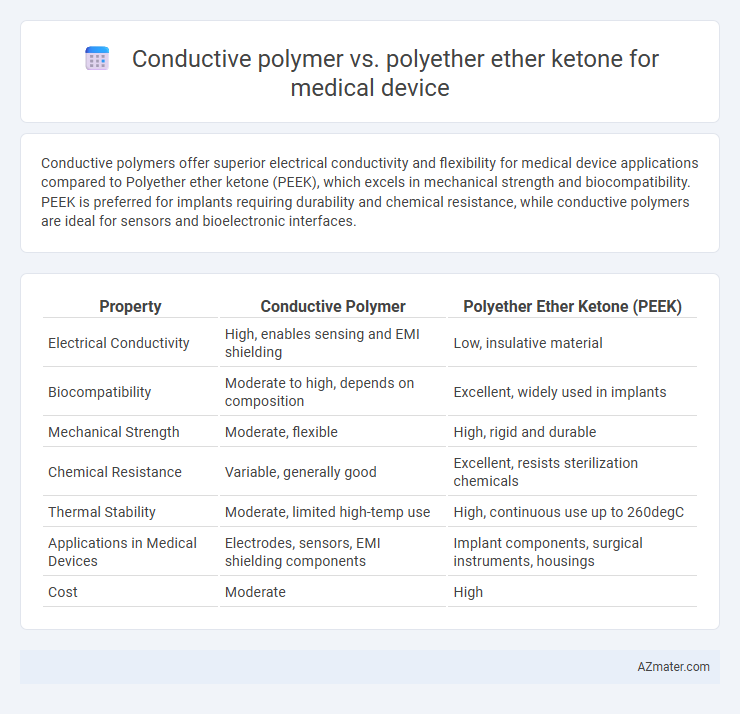Conductive polymers offer superior electrical conductivity and flexibility for medical device applications compared to Polyether ether ketone (PEEK), which excels in mechanical strength and biocompatibility. PEEK is preferred for implants requiring durability and chemical resistance, while conductive polymers are ideal for sensors and bioelectronic interfaces.
Table of Comparison
| Property | Conductive Polymer | Polyether Ether Ketone (PEEK) |
|---|---|---|
| Electrical Conductivity | High, enables sensing and EMI shielding | Low, insulative material |
| Biocompatibility | Moderate to high, depends on composition | Excellent, widely used in implants |
| Mechanical Strength | Moderate, flexible | High, rigid and durable |
| Chemical Resistance | Variable, generally good | Excellent, resists sterilization chemicals |
| Thermal Stability | Moderate, limited high-temp use | High, continuous use up to 260degC |
| Applications in Medical Devices | Electrodes, sensors, EMI shielding components | Implant components, surgical instruments, housings |
| Cost | Moderate | High |
Introduction to Conductive Polymers and Polyether Ether Ketone (PEEK)
Conductive polymers offer unique electrical conductivity and flexibility, making them suitable for biosensors and neural interfaces in medical devices. Polyether ether ketone (PEEK) provides high mechanical strength, chemical resistance, and biocompatibility, ideal for implants and surgical instruments. Both materials address critical challenges in medical device design, balancing functionality, durability, and patient safety.
Chemical Structure and Material Properties Comparison
Conductive polymers exhibit conjugated pi-electron systems enabling electrical conductivity, whereas Polyether ether ketone (PEEK) is a semicrystalline thermoplastic composed of aromatic rings linked by ether and ketone groups, offering high chemical resistance and thermal stability. Conductive polymers provide tunable electrical properties essential for biosensors and neural interfaces, while PEEK's exceptional mechanical strength, biocompatibility, and resistance to sterilization processes make it ideal for structural components in implants. The disparity in chemical structures underpins conductive polymers' flexibility in electronic functionality versus PEEK's robustness and durability in harsh physiological environments.
Electrical Conductivity Differences
Conductive polymers exhibit significantly higher electrical conductivity compared to polyether ether ketone (PEEK), making them ideal for applications requiring efficient charge transport in medical devices. While PEEK offers excellent biocompatibility and mechanical stability, its intrinsic electrical conductivity is negligible, limiting its use in sensors or electrodes. Conductive polymers like polypyrrole or PEDOT can achieve conductivity ranging from 1 to 1000 S/cm, facilitating real-time physiological monitoring and stimulation in implantable devices.
Mechanical Strength and Durability in Medical Devices
Conductive polymers offer moderate mechanical strength and flexibility, making them suitable for applications requiring electrical conductivity and some mechanical resilience in medical devices. Polyether ether ketone (PEEK) exhibits exceptional mechanical strength, high wear resistance, and durability, often outperforming conductive polymers in long-term implantable device applications. The choice between conductive polymers and PEEK depends on the device's requirements for conductivity versus structural integrity and longevity in harsh biological environments.
Biocompatibility and Safety Profiles
Conductive polymers in medical devices offer excellent electrical conductivity and flexibility but often require careful evaluation of biocompatibility due to potential cytotoxicity from dopants or degradation products. Polyether ether ketone (PEEK) exhibits superior biocompatibility and chemical stability, making it a preferred material for implants with minimal inflammatory response and excellent long-term safety profiles. Both materials demand rigorous biocompatibility testing, yet PEEK's proven inertness and resistance to biofouling position it as safer for long-term implantable medical devices.
Applications in Implantable Medical Devices
Conductive polymers, such as polypyrrole and polyaniline, offer excellent electrical conductivity and biocompatibility, making them ideal for neural interfaces and bioelectronic implants. Polyether ether ketone (PEEK) provides superior mechanical strength, chemical resistance, and long-term stability, commonly used in orthopedic and spinal implant components. The choice between conductive polymers and PEEK depends on the specific functional requirements, with conductive polymers favoring sensor and stimulation applications while PEEK supports structural implant durability.
Manufacturing Processes and Scalability
Conductive polymers offer customizable electrical properties and can be processed through solution casting, inkjet printing, or extrusion, enabling rapid prototyping and scalable manufacturing for medical devices. Polyether ether ketone (PEEK) is typically fabricated using high-temperature injection molding or CNC machining, providing excellent mechanical strength and chemical resistance but requiring more complex and costly equipment for large-scale production. Scalability favors conductive polymers in flexible electronic applications due to lower processing temperatures and ease of patterning, while PEEK excels in implantable devices demanding durability and biocompatibility.
Sterilization and Chemical Resistance
Conductive polymers exhibit moderate chemical resistance but often degrade under high-temperature sterilization methods like autoclaving, limiting their use in medical devices requiring frequent sterilization. Polyether ether ketone (PEEK) offers exceptional chemical resistance and withstands rigorous sterilization processes such as steam autoclaving, gamma radiation, and ethylene oxide without significant material degradation. The superior thermal stability and chemical inertness of PEEK make it a preferred choice for medical components subjected to harsh sterilization protocols.
Cost-Effectiveness and Market Availability
Conductive polymers offer cost-effective solutions for medical devices due to their lower material and processing costs compared to Polyether ether ketone (PEEK), which is more expensive but provides superior mechanical strength and chemical resistance. Market availability favors conductive polymers with a wider range of suppliers and formulations tailored for flexible electronics, whereas PEEK's niche market is dominated by specialized manufacturers catering to high-performance orthopedic and implantable devices. Selecting the optimal material depends on balancing budget constraints with performance requirements, where conductive polymers excel in affordability and accessibility, and PEEK delivers premium durability and biocompatibility.
Future Trends and Innovations in Medical Device Materials
Conductive polymers offer promising advancements for medical devices with their flexibility, biocompatibility, and electrical conductivity, enabling innovations in implantable sensors and neural interfaces. Polyether ether ketone (PEEK) remains a leading material due to its exceptional mechanical strength, chemical resistance, and radiolucency, supporting durable and lightweight orthopedic implants. Future trends emphasize hybrid materials combining conductive polymers with PEEK to create multifunctional medical devices that improve performance, patient outcomes, and device longevity.

Infographic: Conductive polymer vs Polyether ether ketone for Medical device
 azmater.com
azmater.com